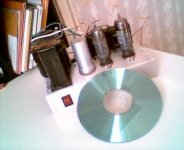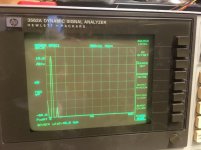Thanks @Fuling ! 🙂
Here are the specs of my Micro-Amp, for comparison 😉 ( https://guilhemamplification.jimdofree.com/hi-fi-other-projects/ ) :

Oh OK - my apologies : I realize 😱 that I'm gently derailing the subject of the thread - driving a 300B with a DHT driver...
Return to the initial path : I remember that I considered for a time to use a single 12AX7 SRPP + a VT25/10Y to drive a 300B, before shifting to the 2-stages 12AX7 parallel SRPP configuration that I described a few posts above with my U-300B. I discarded this option because it was finally too complicated for what it was, and moreover, proved inferior to the // SRPP solution driver in performances.
T
Here are the specs of my Micro-Amp, for comparison 😉 ( https://guilhemamplification.jimdofree.com/hi-fi-other-projects/ ) :
Oh OK - my apologies : I realize 😱 that I'm gently derailing the subject of the thread - driving a 300B with a DHT driver...
Return to the initial path : I remember that I considered for a time to use a single 12AX7 SRPP + a VT25/10Y to drive a 300B, before shifting to the 2-stages 12AX7 parallel SRPP configuration that I described a few posts above with my U-300B. I discarded this option because it was finally too complicated for what it was, and moreover, proved inferior to the // SRPP solution driver in performances.
T
Last edited:
can you post some pictures of your 2xECL82 build ?
I thinks there is a pic of it somewhere in the Photy Gallery, I'll see if I can find it.
Edit: Found it. Even uglier than I remember it, though it doesn't seem finished in the picture. I think it got wooden sides later on. The picture was taken ~20 years ago with an early generation digital camera...:

I think that chassis was just a piece of alu sheet, bent in a vice. Can't remember much of the details, this amp was scrapped years ago when I needed the power transformers for a slightly more serious project (PC900-12B4A SE with homemade C-core OPTs).
The ECL82 mini amp must have been one of my first tube projects, built just for fun after I managed to buy a whole garden shack full of used tubes and radio junk for a couple of Euros at an auction😀
The ECL82 mini amp must have been one of my first tube projects, built just for fun after I managed to buy a whole garden shack full of used tubes and radio junk for a couple of Euros at an auction😀
Hi 45, 50AE, All,The NC-20 (both the old type and ISO-Tango) is really a great IT for SE:SE. It works fine with a great variety of driver tubes with plate resistance from 1K to 5K. It's often considered as a reference by other manufacturers. If you can afford a pair, can find for sale and buy them you will never regret it.
,,,
I have no idea of the current Tango production but there is an "alternative" to the NC-20. ...
Then also 50AE here in the forum, I am told he can make excellent interstages.
A bit of an update:.
The original Hirata Tango NC-20 datasheet (attached) showed conventional connexion for driver valves with plate resistance from 1K to 5K, but with a different connexion for a 10K Ra valve.
The current ISO-Tango NC-20F data sheet (attached) .shows conventional connexion for drivers with plate resistance from 1K to 10K, with frequency response data for all of those. That would include for example the EML 30A which has plate resistance of about 6.5K. Interpolating the frequency response of a 30A driver from the curves would allow one to make a decision of its acceptability based on loudspeaker frequency response.
The implication is that the Hirata NC-20 would be acceptable for use with an EML 30A, which is what I look forward to try since the frequency response degradation is consistent with the Lowther PM2A loudspeakers that I use...we shall see what we shall see.
Best, Robert
Attachments
They are running it as a parallel feed interstage transformer in that arrangement, trying as hard as they can to squeeze ever bit of inductance out of that primary winding that they can. If your source impedance driving the IT is that high, I would question the choice of using the IT in the first place.
As I said before, who cares if the frequency response is down 1 dB @ 40 Hz or 40KHz with a Lowther PM2A?
Best, Robert
Best, Robert
IME, the first thing you need to assess is the output voltage from the driver as function of frequency. Frequency response comes second.Hi 45, 50AE, All,
A bit of an update:.
The original Hirata Tango NC-20 datasheet (attached) showed conventional connexion for driver valves with plate resistance from 1K to 5K, but with a different connexion for a 10K Ra valve.
The current ISO-Tango NC-20F data sheet (attached) .shows conventional connexion for drivers with plate resistance from 1K to 10K, with frequency response data for all of those. That would include for example the EML 30A which has plate resistance of about 6.5K. Interpolating the frequency response of a 30A driver from the curves would allow one to make a decision of its acceptability based on loudspeaker frequency response.
The implication is that the Hirata NC-20 would be acceptable for use with an EML 30A, which is what I look forward to try since the frequency response degradation is consistent with the Lowther PM2A loudspeakers that I use...we shall see what we shall see.
Best, Rob
Both transformers have optimal use at 15-20 mA DC current, depending on the driver one uses and output voltage required. If you have the EML30A, surely 20mA is good starting point. If you run the tube at 30mA both IT's will "suffer, IMHO. The modest difference in primary inductance, in the same conditions, is not a big deal.
So, if the DC current of the driver is 20mA then the max undistorted current one should aim at is a bit less than 20 mA PEAK. Let's say 15 mA peak to aim for low distortion down to the lowest frequency.
The inductance rating is not that different at 20 mA DC current. It is 60H of the NC20 vs 70H of the NC20F with small signal. With large signal it will be better.
The NC20 is rated 60H with 1V signal and 100H with larger signal (normally as soon as the signal gets above a certain medium level the inductance doesn't grow anymore, or decrease, as long as the core works in the linear region).
If the max peak current required to the driver is 15 mA, the lowest frequency of interest is 20Hz and the inductance is 100H with a DC quiescent current of 20mAt then you max undistorted output will be:
Vpeak= 4.44*Ipeak*L*f = 133V !
This is also well within the max specified output voltage (150 Vrms at 10 Hz with 20 mA DC) which means "well within the linear region)".
Regarding the frequency response the larger plate resistance of the EML30 will have a bigger effect at high frequency by reducing the bandwidth. However this is about 7K or less at 20mA, so I would expect a behaviour close to the 5K case.
At low frequency I would expect the cut-off around 20Hz with just 1V (milliwatt outpower if not less...) and some 10-12Hz with large signal.
In my opinion, you don't need the parafeed connection.
IME, the first thing you need to assess is the output voltage from the driver as function of frequency. ...
45,Vpeak= 4.44*Ipeak*L*f = 133V !
This is also well within the max specified output voltage (150 Vrms at 10 Hz with 20 mA DC) which means "well within the linear region)".
...
In my opinion, you don't need the parafeed connection.
Grazie Mille for your astute invocation of Faraday's laws of electromagnetic induction!
And for confirming, in your opinion, that I can proceed without parafeed.
Best, Robert
P.S. I'm quite sure that my awareness of Faraday's laws were much better in my days at university in the early 1960s than they have been up to now...Thanks!
- Home
- Amplifiers
- Tubes / Valves
- 300B SE with a DHT driver


